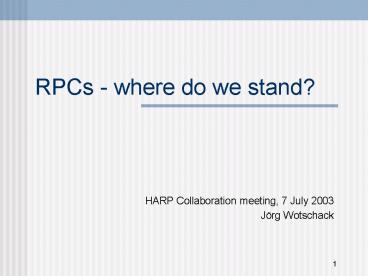RPCs - where do we stand? - PowerPoint PPT Presentation
1 / 18
Title:
RPCs - where do we stand?
Description:
Pattison, S. Robins, A. De Santo (now at Royal Holloway College) IHEP Protvino: V. Koreshev ... Main results are based on calibration/scan data ... – PowerPoint PPT presentation
Number of Views:24
Avg rating:3.0/5.0
Title: RPCs - where do we stand?
1
RPCs - where do we stand?
- HARP Collaboration meeting, 7 July 2003
- Jörg Wotschack
2
The team
- Oxford
- G. Barr, Ch. Pattison, S. Robins, A. De Santo
(now at Royal Holloway College) - IHEP Protvino
- V. Koreshev
- CERN
- (M. Bogomilov), J. Wotschack
3
Data analysis
- ... so far based on
- 2001 ntuples Large angle data (Ta 3 GeV)
- 150000 RPC hits in barrel (few hundert/pad)
- Only 50 of hits correlated with good tracks
- 2002 ntuples various smaller data sets
- Partly incomplete information in ntuples
- Statistics insufficient
- Not useful for systematic analysis
- Calibration scan data (4 spare RPCs)
4
Results - calibration
- Main results are based on calibration/scan data
- Time-slewing correction - unique for all RPC pads
(ADS, VK) - Systematic studies of response as function of
beam impact point (VK) - Little dependance on position along pad (z)
- Significant dependence on hit distance to PA
(charge dependent) - Alignment in z and phi wrt TPC (ChP)
- TDC calibration (Ch. Wiebusch) ps/TDC count
5
Corr-4.75.97 104/Q-2.65 107/Q21.66 1010/Q3
Ttime-slewing correction Corrab/Qc/Q2d/Q3
QQmeas-QpedQoffset Qoffset 394.4
Qmeas- Qped
6
3 TDC counts
TDC counts
Variation of response along pad (z)
Variation of response across pad with distance to
preamplifier Slope (TPA-Tend)/L TDC
counts/mm
7
Results - particle identification
3 GeV Ta data (2001) - thin target
T0s not yet well determined
8
Missing ...
- Good T0 calibration of pads
- Required precision 100 ps (3 TDC counts)
- Need sufficient statistics (gt1000 hits/pad) and
reliably reconstructed tracks - Three methods are being used to solve the problem
9
Method I
- Use charged tracks with known momentum and
particle id measure the tracklength and the time
and compare to nominal time of flight - Best method in principle
- Relies on good knowledge of p, L, and particle
type - Protons 10 momentum error leads to an error of
20 TDC counts for a 1m long proton track for
pp0.5 GeV/c - Pions dp/p10 for 200 MeV/c corresp. to 100 ps
- Separation of e/p not possible in this step
10
Method II (overlapping pads)
- Tracks through overlaps b/w pads
- Same track through pads A and B
- Gives relative response b/w all pads in one pad
ring i.e., can adjust all pads in ring to same
scale - Independent of momentum measurement and particle
id - Requires still absolute t0 determination for the
eigth pad rings in barrel same difficulties as
in Method I but statistically much better - Of limited use in forward RPCs
11
Tracks through overlapping pads
Ideal tool to test T0 determination
Time difference in ns for identical tracks
measured in two overlapping pads after t0
determination with neutrals. Example of a good
case Gives (convoluted) time resolution of the
two pads involved.
s280 ps
12
Method III (neutrals)
- Use photons converting in material in front of
(or in) RPCs - Signature no track pointing to RPC pad but good
signal (in time and charge) in pad - Advantages
- independent of momentum measurement
- Straight tracks
- Known beta (relativistic particles)
- Disadvantages
- no tracklength info, averages over pad but mean
values are well known
13
Selection of photons
- Select beam protons and ITC trigger
- Require at least one good track coming from
target, confirmed by RPC hit, i.e., there was an
interaction in time - Scan over all RPC pad hits
- Require that there is no track pointing to this
pad or close by - Exclude small charges (qdc lt 100 counts) small
charge signals are expected from Compton
scattering of MeV photons. Mainly
(back)scattering photons not coming from the
target
14
Signal
- Typical time spectrum of hits in RPC pad w/o
associated track
Tail from not tagged charged particles
Low energy backscattered photons
15
Example for problem case
- Known problem areas
- TPC sector boundaries
- Dead areas in TPC
- Other difficulties
- Cross-talk induced effects
- Difficult pattern recognition
- Overlays
16
Tracks or no tracks
Phi0 from TPC
RPC hits/chamber
All fitted tracks
Dead channels (1/8 pads in chb)
Extrapolation to RPCs gt9 hits/track
gt12 hits/track
2 chambers/bin
17
Strategy
- Proceed in parallel with all three methods
- Expect (in the end) to find the same calibration
constants from all three methods - Produce private LA ntuples with thin and low z
material targets (Be or Al, pbeam 8.9 GeV) - Minimize p0 conversion in target (large rad.
length) gt enhanced number of p0 conversions in
TPC f.c. - Minimize re-interaction in target (large inter.
length) gt cleaner sample of tracks pointing to
IP - Keep all TPC clusters (also those not connected
to a track) - When barrel is done try methods on forward RPCs
18
Conclusions
- Internal RPC calibration parameters largely
understood - Missing T0 determination of RPC pads, i.e.,
absolute time scale for each individual RPC
channel - Three methods are proposed (charged, overlap,
neutral) to cross-check results - Needs large statistics data sets with complete
TPC info (clusters) and well reconstructed tracks - Using neutrals requires selection of clean sample
of no-track hits in RPCs and therefore all TPC
hits in ntuples - Private ntuple production about to start ...































